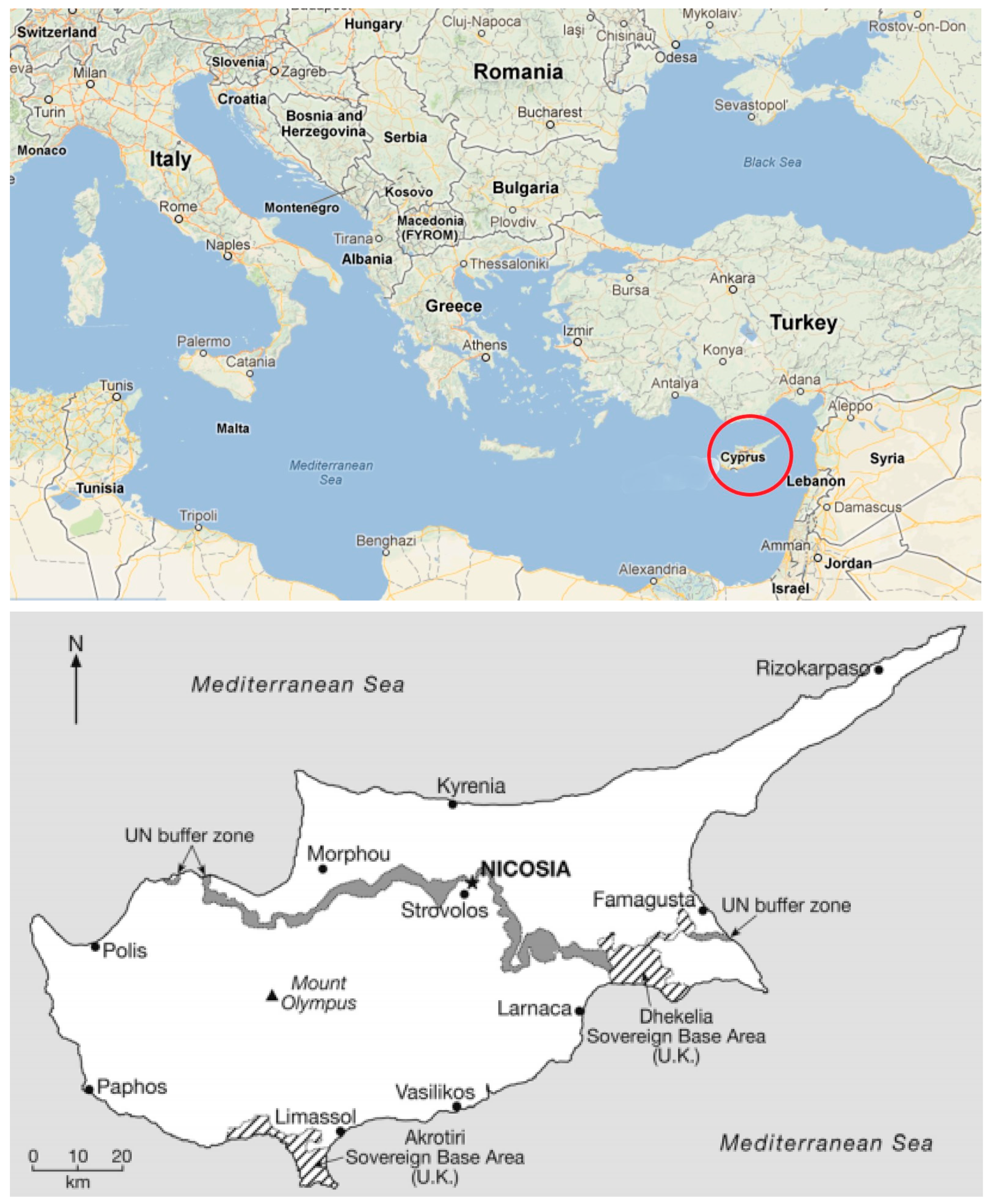Reinventing the Urban Neighborhood Green Index in the Context of Urban Ecology as a Conceptual Framework in Northern Nicosia, Cyprus
Abstract
1. Introduction
2. Literature Review
2.1. Urban Ecology as the Main Feature of Ecological Planning
2.2. Urban Green Spaces
Green Spaces at the Neighborhood Scale
2.3. Urban Neighborhood Green Index (UNGI)
3. Material and Methodology
3.1. Research Area
3.2. Research Design
3.2.1. Per-Capita Open Green Space
3.2.2. Proximity to Green Space
3.2.3. Area Percentages
3.2.4. Types of Green Spaces
4. Findings
4.1. Per Capita Open Green Spaces
4.2. Proximity to Green Space
4.3. Area Percentages
4.4. Types of Green Spaces
5. Discussion
6. Conclusions
Author Contributions
Funding
Institutional Review Board Statement
Informed Consent Statement
Data Availability Statement
Conflicts of Interest
References
- Duman, Ü.; Asilsoy, B. Developing an Evidence-Based Framework of Universal Design in the Context of Sustainable Urban Planning in Northern Nicosia. Sustainability 2022, 14, 13377. [Google Scholar] [CrossRef]
- Chen, X.; Wu, J. Sustainable landscape architecture: Implications of the Chinese philosophy of “unity of man with nature” and beyond. Landsc. Ecol. 2009, 24, 1015–1026. [Google Scholar] [CrossRef]
- He, J.; Bao, C.-K.; Shu, T.-F.; Yun, X.-X.; Jiang, D.; Brown, L. Framework for integration of urban planning, strategic environmental assessment and ecological planning for urban sustainability within the context of China. Environ. Impact Assess. Rev. 2011, 31, 549–560. [Google Scholar] [CrossRef]
- Çoban, A.; Yücel, M. Kent Planlamasında Ekosistem Hizmetlerinin Rolü. Düzce Üniv. Bilim Teknol. Derg. 2018, 6, 444–454. [Google Scholar]
- Pickett, S.T.A.; Cadenasso, M.L.; Grove, J.M.; Groffman, P.M.; Band, L.E.; Boone, C.G.; Burch, W.R.; Grimmond, C.S.B.; Hom, J.; Jenkins, J.C.; et al. Beyond Urban Legends: An Emerging Framework of Urban Ecology, as Illustrated by the Baltimore Ecosystem Study. BioScience 2008, 58, 139–150. [Google Scholar] [CrossRef]
- Aronson, M.F.; Lepczyk, C.A.; Evans, K.L.; Goddard, M.A.; Lerman, S.B.; MacIvor, J.S.; Nilon, C.H.; Vargo, T. Biodiversity in the city: Key challenges for urban green space management. Front. Ecol. Environ. 2017, 15, 189–196. [Google Scholar] [CrossRef]
- Wolch, J.R.; Byrne, J.; Newell, J.P. Urban green space, public health, and environmental justice: The challenge of making cities ‘just green enough’. Landsc. Urban Plan. 2014, 125, 234–244. [Google Scholar] [CrossRef]
- Wendel, H.E.W.; Zarger, R.K.; Mihelcic, J.R. Accessibility and usability: Green space preferences, perceptions, and barriers in a rapidly urbanizing city in Latin America. Landsc. Urban Plan. 2012, 107, 272–282. [Google Scholar] [CrossRef]
- Agudelo-Vera, C.M.; Mels, A.R.; Keesman, K.J.; Rijnaarts, H.H. Resource management as a key factor for sustainable urban planning. J. Environ. Manag. 2011, 92, 2295–2303. [Google Scholar] [CrossRef]
- Stratigea, A.; Papadopoulou, C.-A.; Panagiotopoulou, M. Tools and Technologies for Planning the Development of Smart Cities. J. Urban Technol. 2015, 22, 43–62. [Google Scholar] [CrossRef]
- Haarstad, H. Constructing the sustainable city: Examining the role of sustainability in the ‘smart city’ discourse. J. Environ. Policy Plan. 2017, 19, 423–437. [Google Scholar] [CrossRef]
- Brilhante, O.; Klaas, J. Green City Concept and a Method to Measure Green City Performance over Time Applied to Fifty Cities Globally: Influence of GDP, Population Size and Energy Efficiency. Sustainability 2018, 10, 2031. [Google Scholar] [CrossRef]
- El Ghorab, H.K.; Shalaby, H.A. Eco and Green cities as new approaches for planning and developing cities in Egypt. Alex. Eng. J. 2016, 55, 495–503. [Google Scholar] [CrossRef]
- Çetinkaya, Ç. Eko-Kentler: Kent Ve Doğa İlişkisinde Yeni Bir Sistem Tasarımı. Türk Bilimsel Derlemeler Derg. 2013, 6, 12–16. [Google Scholar]
- Van Dijk, P.M. Beijing and Rotterdam Eco Cities? Using 100 Criteria for a Classification of Ecological Cities Paper; TU Delft: Delft, The Netherlands, 2010. [Google Scholar]
- Choon, S.W.; Siwar, C.; Pereira, J.J.; Jemain, A.A.; Hashim, H.S.; Hadi, A.S. A sustainable city index for Malaysia. Int. J. Sustain. Dev. World Ecol. 2011, 18, 28–35. [Google Scholar] [CrossRef]
- Breuste, J.; Qureshi, S. Urban sustainability, urban ecology and the Society for Urban Ecology (SURE). Urban Ecosyst. 2011, 14, 313–317. [Google Scholar] [CrossRef]
- Wu, J.; Xiang, W.-N.; Zhao, J. Urban ecology in China: Historical developments and future directions. Landsc. Urban Plan. 2014, 125, 222–233. [Google Scholar] [CrossRef]
- Karadağ, A. Kentsel Ekoloji: Kentsel Çevre Analizlerinde Coğrafi Yaklaşım. Ege Coğrafya Derg. 2009, 18, 31–47. [Google Scholar]
- Leitao, A.B.; Ahern, J. Applying landscape ecological concepts and metrics in sustainable landscape planning. Landsc. Urban Plan. 2002, 59, 65–93. [Google Scholar] [CrossRef]
- Wilby, R.L.; Perry, G.L. Climate change, biodiversity and the urban environment: A critical review based on London, UK. Prog. Phys. Geogr. Earth Environ. 2006, 30, 73–98. [Google Scholar] [CrossRef]
- Yıldırım, S.; Asilsoy, B.; Özden, Ö. Urban Resident Views about Open Green Spaces: A Study in Güzelyurt (Morphou), Cyprus. Eur. J. Sustain. Dev. 2020, 9, 441–450. [Google Scholar] [CrossRef]
- Pirasteh, S.; Ali, S.A.; Hussain, H.J. Greenrey (Green Space) Percentage Estimation Using Band Ratio, NDVI from Landsat Enhanced Thematic Mapper (ETM)-2002 & An Application of Geographic Information System (GIS) Techniques, Dezful-Andimeshk, Khuzestan South-West Iran. In Proceedings of the 8th Annual International Conference, New Delhi, India, 7–9 February 2005. [Google Scholar]
- Kong, F.; Nakagoshi, N. Spatial-temporal gradient analysis of urban green spaces in Jinan, China. Landsc. Urban Plan. 2006, 78, 147–164. [Google Scholar] [CrossRef]
- Sanesi, G.; Chiarello, F. Residents and urban green spaces: The case of Bari. Urban For. Urban Green. 2006, 4, 125–134. [Google Scholar] [CrossRef]
- Cilliers, S.; Cilliers, J.; Lubbe, R.; Siebert, S. Ecosystem services of urban green spaces in African countries—perspectives and challenges. Urban Ecosyst. 2013, 16, 681–702. [Google Scholar] [CrossRef]
- Kabisch, N.; Strohbach, M.; Haase, D.; Kronenberg, J. Urban green space availability in European cities. Ecol. Indic. 2016, 70, 586–596. [Google Scholar] [CrossRef]
- Taylor, L.; Hochuli, D.F. Defining greenspace: Multiple uses across multiple disciplines. Landsc. Urban Plan. 2017, 158, 25–38. [Google Scholar] [CrossRef]
- Kabisch, N.; Haase, D. Green justice or just green? Provision of urban green spaces in Berlin, Germany. Landsc. Urban Plan. 2014, 122, 129–139. [Google Scholar] [CrossRef]
- Di, S.; Li, Z.-L.; Tang, R.; Pan, X.; Liu, H.; Niu, Y. Urban green space classification and water consumption analysis with remote-sensing technology: A case study in Beijing, China. Int. J. Remote Sens. 2019, 40, 1909–1929. [Google Scholar] [CrossRef]
- Van Herzele, A.; Wiedemann, T. A monitoring tool for the provision of accessible and attractive urban green spaces. Landsc. Urban Plan. 2003, 63, 109–126. [Google Scholar] [CrossRef]
- Atila, G.; Küçük, V. Kentsel Açik-Yeşil Alanlar Ve Isparta Kenti Örneğinde İrdelenmesi. Türkiye Orman. Derg. 2001, 2, 27–48. [Google Scholar]
- Sugiyama, T.; Carver, A.; Koohsari, M.J.; Veitch, J. Advantages of public green spaces in enhancing population health. Landsc. Urban Plan. 2018, 178, 12–17. [Google Scholar] [CrossRef]
- Körmeçli, P.Ş. Kentsel Alanlarda Erişilebilirlik ve Sosyal Etkileşim İlişkisinin Irdelenmesi: Ankara Çukurambar Mahallesi Örneği; Ankara University: Ankara, Turkey, 2019. [Google Scholar]
- Erdönmez, M.E.; Akı, A. Açık kamusal kent mekanlarının toplum ilişkilerindeki etkileri. Megaron 2005, 1, 67. [Google Scholar]
- Khan, A.M.; Rana, M.S.; Rashied, M.; Mahmud, M.A.; Pramanik, M.A.; Rahman MS, U.; Rashid MH, O. Revisiting Planning Standards for Open Spaces in Urban Areas from Global and National Perspectives. J. Bangladesh Inst. Plan. ISSN 2019, 2075, 9363. [Google Scholar]
- Moseley, D.; Marzano, M.; Chetcuti, J.; Watts, K. Green networks for people: Application of a functional approach to support the planning and management of greenspace. Landsc. Urban Plan. 2013, 116, 1–12. [Google Scholar] [CrossRef]
- Gupta, K.; Kumar, P.; Pathan, S.K.; Sharma, K.P. Urban Neighborhood Green Index—A measure of green spaces in urban areas. Landsc. Urban Plan. 2012, 105, 325–335. [Google Scholar] [CrossRef]
- Sharifi, A. From Garden City to Eco-urbanism: The quest for sustainable neighborhood development. Sustain. Cities Soc. 2016, 20, 1–16. [Google Scholar] [CrossRef]
- Jim, C.; Chen, S.S. Comprehensive greenspace planning based on landscape ecology principles in compact Nanjing city, China. Landsc. Urban Plan. 2003, 65, 95–116. [Google Scholar] [CrossRef]
- Perry, M.A.; Devan, H.; Fitzgerald, H.; Han, K.; Liu, L.T.; Rouse, J. Accessibility and usability of parks and playgrounds. Disabil. Health J. 2018, 11, 221–229. [Google Scholar] [CrossRef]
- Akbulut, Ç.D.; Önder, S. Aksaray Kenti Açık-Yeşil Alanlarının Nitelik Ve Nicelik Yönünden İncelenmesi. Selcuk. J. Agric. Food Sci. 2011, 25, 90–95. [Google Scholar]
- Van Helden, B.E.; Close, P.G.; Stewart, B.A.; Speldewinde, P.C.; Comer, S.J. An underrated habitat: Residential gardens support similar mammal assemblages to urban remnant vegetation. Biol. Conserv. 2020, 250, 108760. [Google Scholar] [CrossRef]
- Hussain, M.R.M.; Tukiman, I.; Zen, I.H.; Shahli, F.M. The Impact of Landscape Design on House Prices and Values in Residential Development in Urban Areas. APCBEE Procedia 2014, 10, 316–320. [Google Scholar] [CrossRef][Green Version]
- Mahmoud, A.H.A. Analysis of the microclimatic and human comfort conditions in an urban park in hot and arid regions. Build. Environ. 2011, 46, 2641–2656. [Google Scholar] [CrossRef]
- Shahli, F.M.; Hussain MR, M. Implementation of Landscape Design as Elements in Creating Values for Housing Areas in Klang Valley, Malaysia. Am. Trans. Eng. Appl. Sci. 2015, 4, 219–230. [Google Scholar]
- Stessens, P.; Khan, A.Z.; Huysmans, M.; Canters, F. Analysing urban green space accessibility and quality: A GIS-based model as spatial decision support for urban ecosystem services in Brussels. Ecosyst. Serv. 2017, 28, 328–340. [Google Scholar] [CrossRef]
- Zhang, Y.; Van den Berg, A.E.; Van Dijk, T.; Weitkamp, G. Quality over Quantity: Contribution of Urban Green Space to Neighborhood Satisfaction. Int. J. Environ. Res. Public Health 2017, 14, 535. [Google Scholar] [CrossRef]
- Gupta, K.; Roy, A.; Luthra, K.; Maithani, S. Mahavir GIS based analysis for assessing the accessibility at hierarchical levels of urban green spaces. Urban For. Urban Green. 2016, 18, 198–211. [Google Scholar] [CrossRef]
- Zhu, Z.; Lang, W.; Tao, X.; Feng, J.; Liu, K. Exploring the Quality of Urban Green Spaces Based on Urban Neighborhood Green Index—A Case Study of Guangzhou City. Sustainability 2019, 11, 5507. [Google Scholar] [CrossRef]
- La Rosa, D. Accessibility to greenspaces: GIS based indicators for sustainable planning in a dense urban context. Ecol. Indic. 2014, 42, 122–134. [Google Scholar] [CrossRef]
- Neuvonen, M.; Sievänen, T.; Tönnes, S.; Koskela, T. Access to green areas and the frequency of visits—A case study in Helsinki. Urban For. Urban Green. 2007, 6, 235–247. [Google Scholar] [CrossRef]
- Richards, D.R.; Passy, P.; Oh, R.R. Impacts of population density and wealth on the quantity and structure of urban green space in tropical Southeast Asia. Landsc. Urban Plan. 2017, 157, 553–560. [Google Scholar] [CrossRef]
- Veal, A. Open space planning standards in Australia: In search of origins. Aust. Plan. 2013, 50, 224–232. [Google Scholar] [CrossRef]
- Anguluri, R.; Narayanan, P. Role of green space in urban planning: Outlook towards smart cities. Urban For. Urban Green. 2017, 25, 58–65. [Google Scholar] [CrossRef]
- Maryanti, M.; Khadijah, H.; Uzair, A.M.; Ghazali, M.M.M. The urban green space provision using the standards approach: Issues and challenges of its implementation in Malaysia. WIT Trans. Ecol. Environ. 2017, 210, 369–379. [Google Scholar]
- Khalil, R. Quantitative evaluation of distribution and accessibility of urban green spaces (Case study: City of Jeddah). Int. J. Geomat. Geosci. 2014, 4, 526–535. [Google Scholar]
- Hofmann, M.; Westermann, J.R.; Kowarik, I.; van der Meer, E. Perceptions of parks and urban derelict land by landscape planners and residents. Urban For. Urban Green. 2012, 11, 303–312. [Google Scholar] [CrossRef]
- Gozalo, G.R.; Morillas, J.M.B.; González, D.M. Perceptions and use of urban green spaces on the basis of size. Urban For. Urban Green. 2019, 46, 126470. [Google Scholar] [CrossRef]
- Christoforidi, I.; Kollaros, D.; Papadakaki, M.; Psaroudaki, A.; Antoniou, T.; Daliakopoulos, I.N. A novel index for assessing perceived availability and public demand for urban green space: Application in a Mediterranean island. Urban For. Urban Green. 2022, 69, 127498. [Google Scholar] [CrossRef]
- Rosol, M. Public Participation in Post-Fordist Urban Green Space Governance: The Case of Community Gardens in Berlin. Int. J. Urban Reg. Res. 2010, 34, 548–563. [Google Scholar] [CrossRef]
- Vargas-Hernández, J.G.; Pallagst, K.; Zdunek-Wielgołaska, J. Urban green spaces as a component of an ecosystem. Functions, services, users, community involvement, initiatives and actions. Rev. Urban. 2017, 37, 1–26. [Google Scholar] [CrossRef]
- Abdelhamid, M.M.; Elfakharany, M.M. Improving urban park usability in developing countries: Case study of Al-Shalalat Park in Alexandria. Alex. Eng. J. 2020, 59, 311–321. [Google Scholar] [CrossRef]
- Delipetrou, P.; Makhzoumi, J.; Dimopoulos, P.; Georghiou, K. Cyprus. In Mediterranean Island Landscapes; Springer: Dordrecht, The Netherlands, 2008; pp. 170–203. [Google Scholar]
- Della, A.; Paraskeva-Hadjichambi, D.; Hadjichambis, A.C. An ethnobotanical survey of wild edible plants of Paphos and Larnaca countryside of Cyprus. J. Ethnobiol. Ethnomed. 2006, 2, 34. [Google Scholar] [CrossRef]
- Gürkan, H. Dünkü ve Bügünkü Lefkoşa Toplu Eserler 3; Galeri Kültür Yayınları: Lefkoşa, Cyprus, 1996; pp. 11–85. [Google Scholar]
- Günçe, K.; Mısırlısoy, D. Assessment of Adaptive Reuse Practices through User Experiences: Traditional Houses in the Walled City of Nicosia. Sustainability 2019, 11, 540. [Google Scholar] [CrossRef]
- Bolkaner, M.K.; Asilsoy, B.; Uzunoğlu, S.S. A Study about Urban Design Schemes: Walled City of Nicosia. Eur. J. Sustain. Dev. 2020, 9, 549. [Google Scholar] [CrossRef]
- Ciftcioglu, G.C.; Aydin, A. Urban ecosystem services delivered by green open spaces: An example from Nicosia City in North Cyprus. Environ. Monit. Assess. 2018, 190, 613. [Google Scholar] [CrossRef] [PubMed]
- Zafersoy, H.; Batırbaygil, H. Urban Integrity: The City of Nicosia, Turkish Republic of Northern Cyprus/Kentsel Bütünleşiklik: Kuzey Kıbrıs Türk Cumhuriyeti Lefkoşa Kenti Örneği. Megaron 2014, 9, 289. [Google Scholar] [CrossRef]
- Jia, J.; Zlatanova, S.; Liu, H.; Aleksandrov, M.; Zhang, K. A design-support framework to assess urban green spaces for human wellbeing. Sustain. Cities Soc. 2023, 98, 104779. [Google Scholar] [CrossRef]
- Xu, C.; Chen, G.; Huang, Q.; Su, M.; Rong, Q.; Yue, W.; Haase, D. Can improving the spatial equity of urban green space mitigate the effect of urban heat islands? An empirical study. Sci. Total. Environ. 2022, 841, 156687. [Google Scholar] [CrossRef]
- Chen, J.; Kinoshita, T.; Li, H.; Luo, S.; Su, D.; Yang, X.; Hu, Y. Toward green equity: An extensive study on urban form and green space equity for shrinking cities. Sustain. Cities Soc. 2023, 90, 104395. [Google Scholar] [CrossRef]
- Liu, Y.; Meng, Q.; Zhang, J.; Zhang, L.; Jancso, T.; Vatseva, R. An effective Building Neighborhood Green Index model for measuring urban green space. Int. J. Digit. Earth 2016, 9, 387–409. [Google Scholar] [CrossRef]
- Jang, K.M.; Kim, J.; Lee, H.-Y.; Cho, H.; Kim, Y. Urban Green Accessibility Index: A Measure of Pedestrian-Centered Accessibility to Every Green Point in an Urban Area. ISPRS Int. J. Geo-Inf. 2020, 9, 586. [Google Scholar] [CrossRef]
- Pouya, S.; Aghlmand, M. Evaluation of urban green space per capita with new remote sensing and geographic information system techniques and the importance of urban green space during the COVID-19 pandemic. Environ. Monit. Assess. 2022, 194, 633. [Google Scholar] [CrossRef] [PubMed]
- Badiu, D.L.; Iojă, C.I.; Pătroescu, M.; Breuste, J.; Artmann, M.; Niță, M.R.; Grădinaru, S.R.; Hossu, C.A.; Onose, D.A. Is urban green space per capita a valuable target to achieve cities’ sustainability goals? Romania as a case study. Ecol. Indic. 2016, 70, 53–66. [Google Scholar] [CrossRef]
- Ramalho, C.E.; Hobbs, R.J. Time for a change: Dynamic urban ecology. Trends Ecol. Evol. 2012, 27, 179–188. [Google Scholar] [CrossRef] [PubMed]
- Seto, K.C.; Satterthwaite, D. Interactions between urbanization and global environmental change. Curr. Opin. Environ. Sustain. 2010, 2, 127–128. [Google Scholar] [CrossRef]
- Gulsrud, N.M.; Gooding, S.; Konijnendijk van den Bosch, C.C. Green space branding in Denmark in an era of neoliberal governance. Urban For. Urban Green. 2013, 12, 330–337. [Google Scholar] [CrossRef]
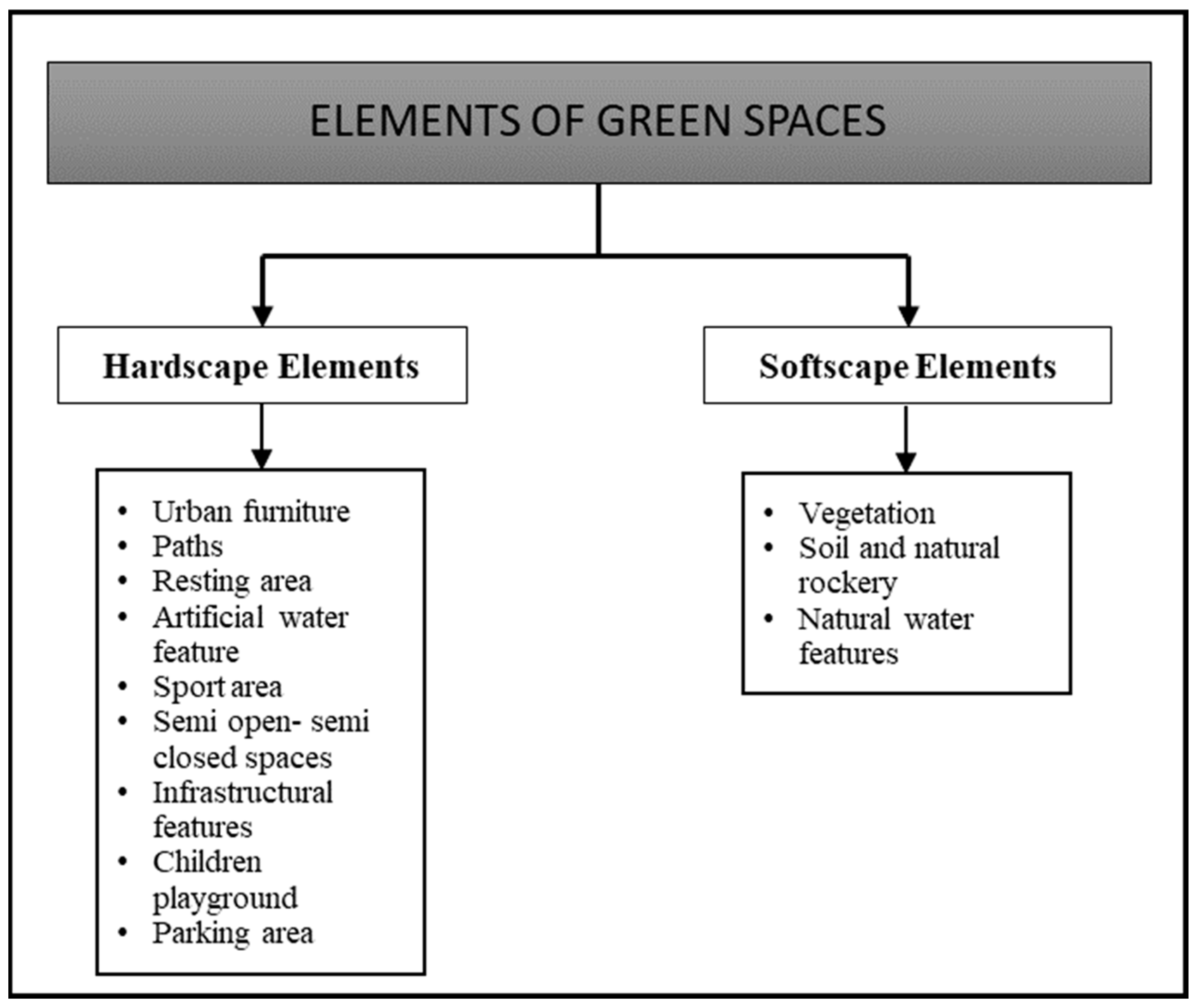
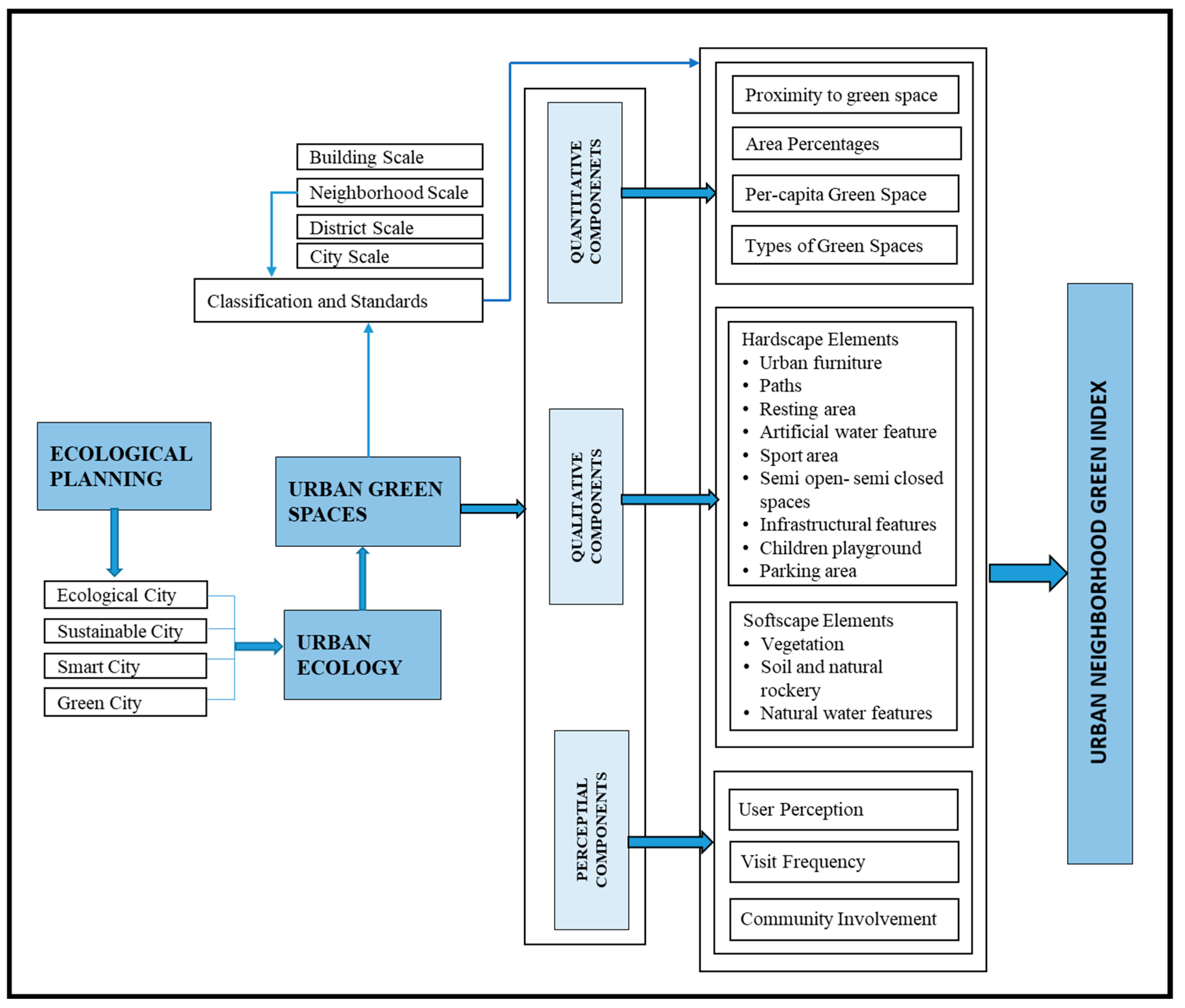
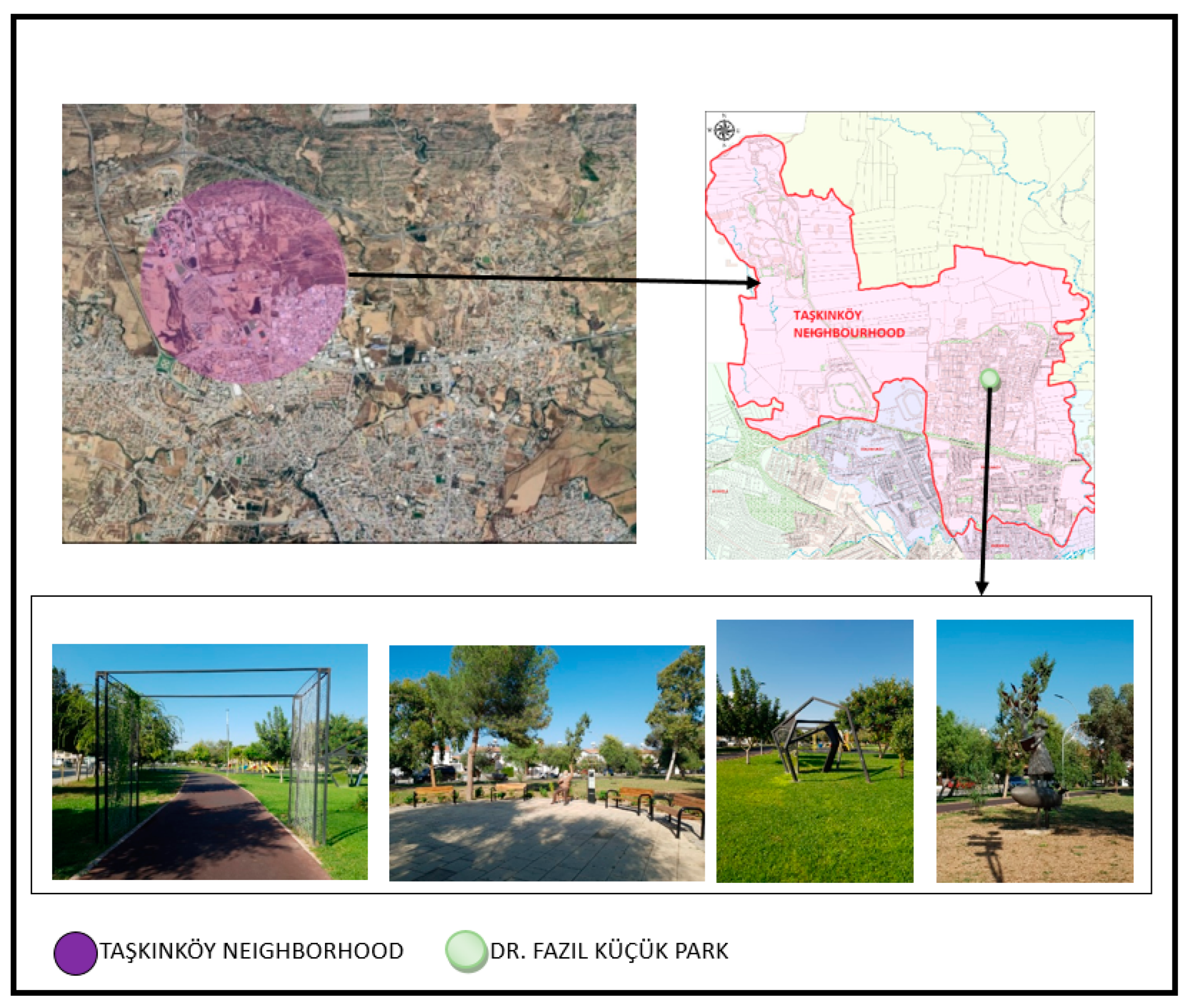
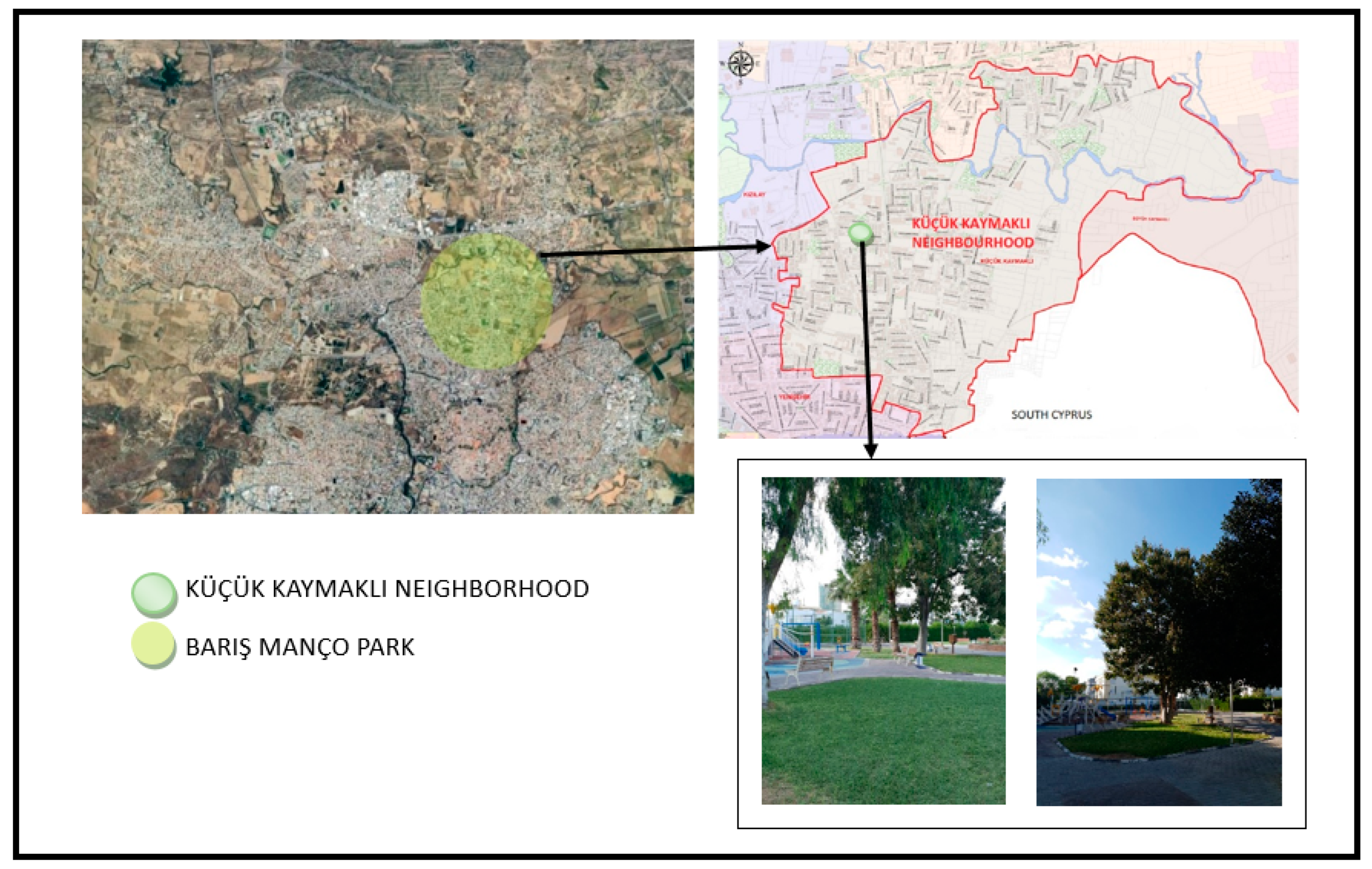
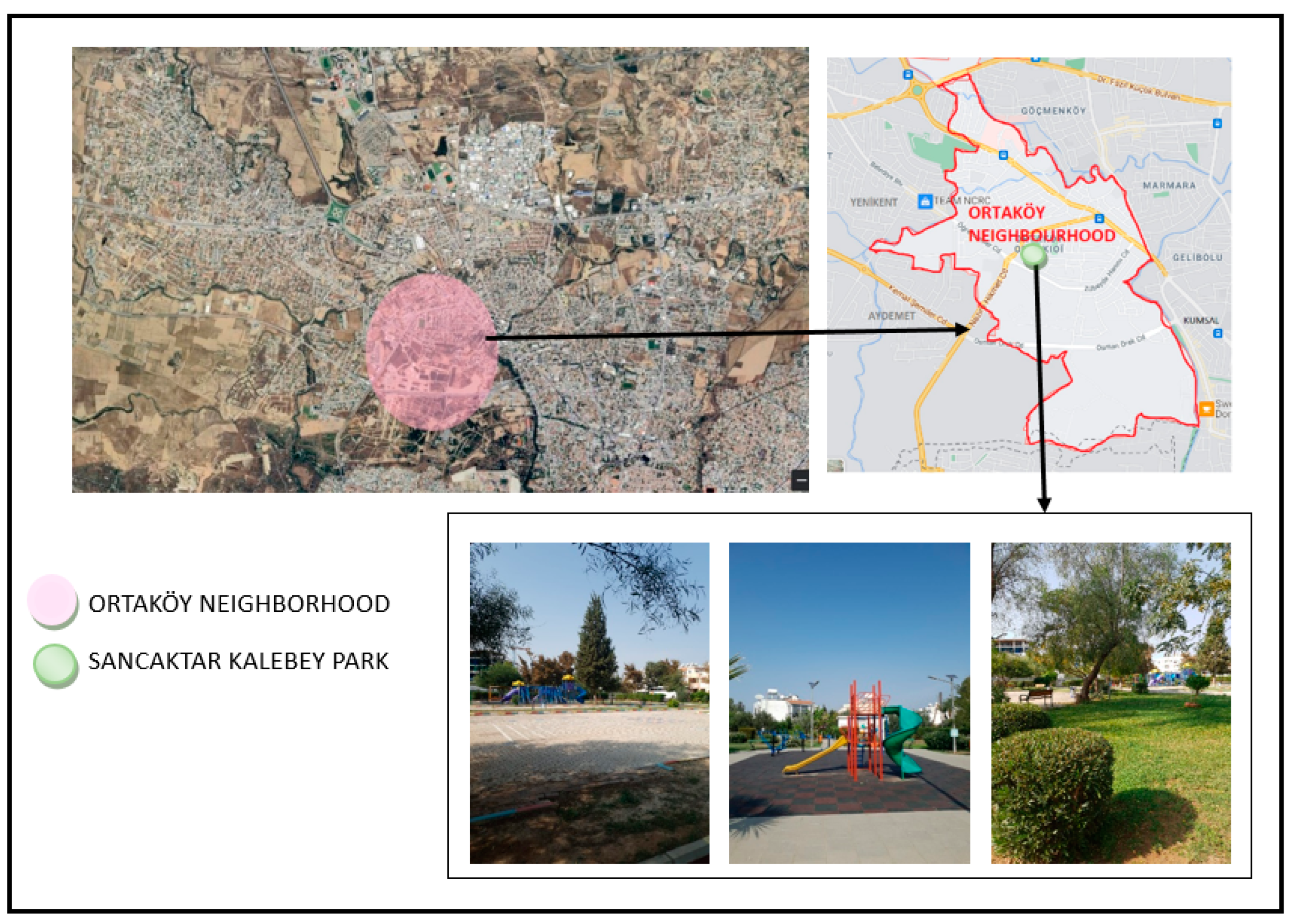
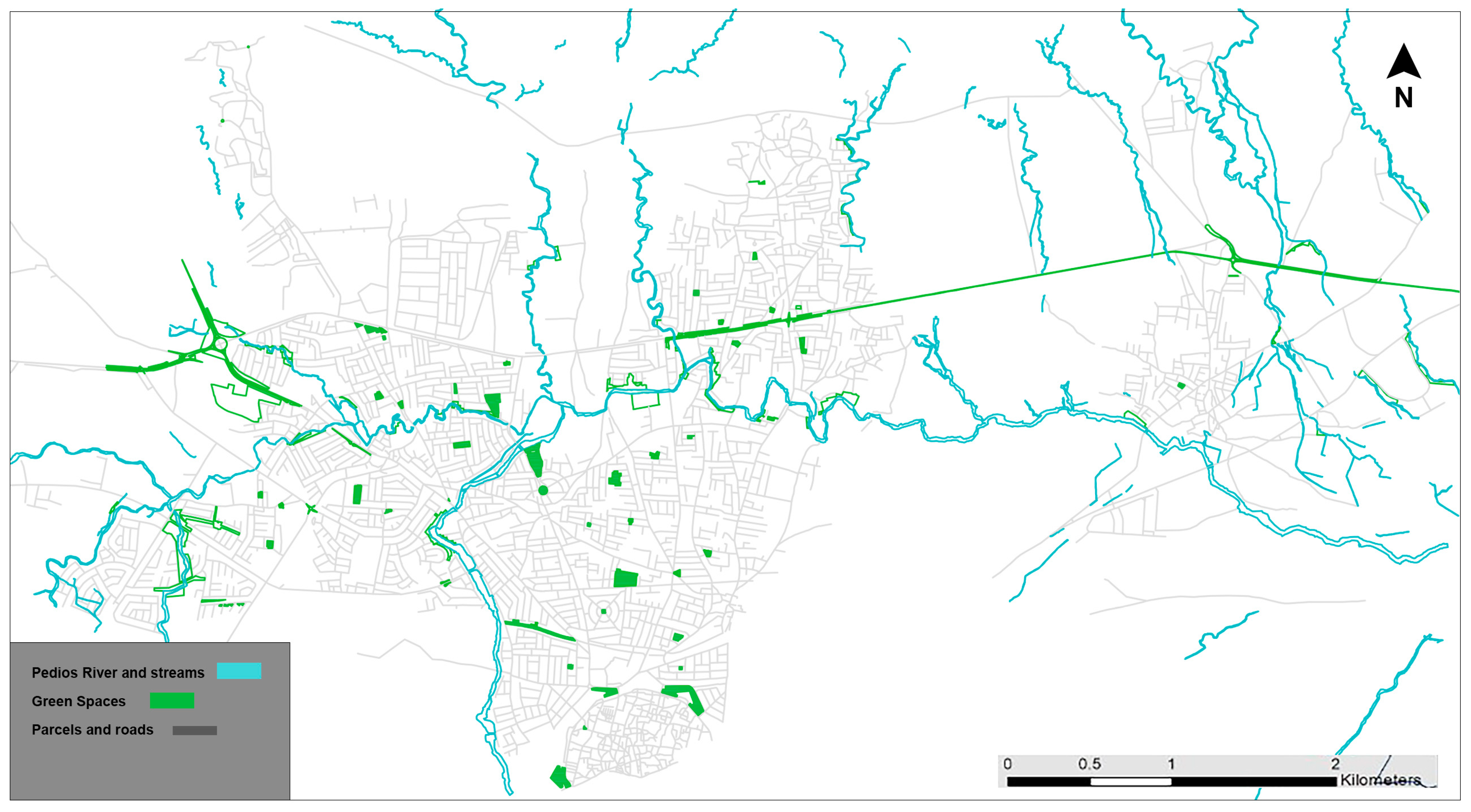
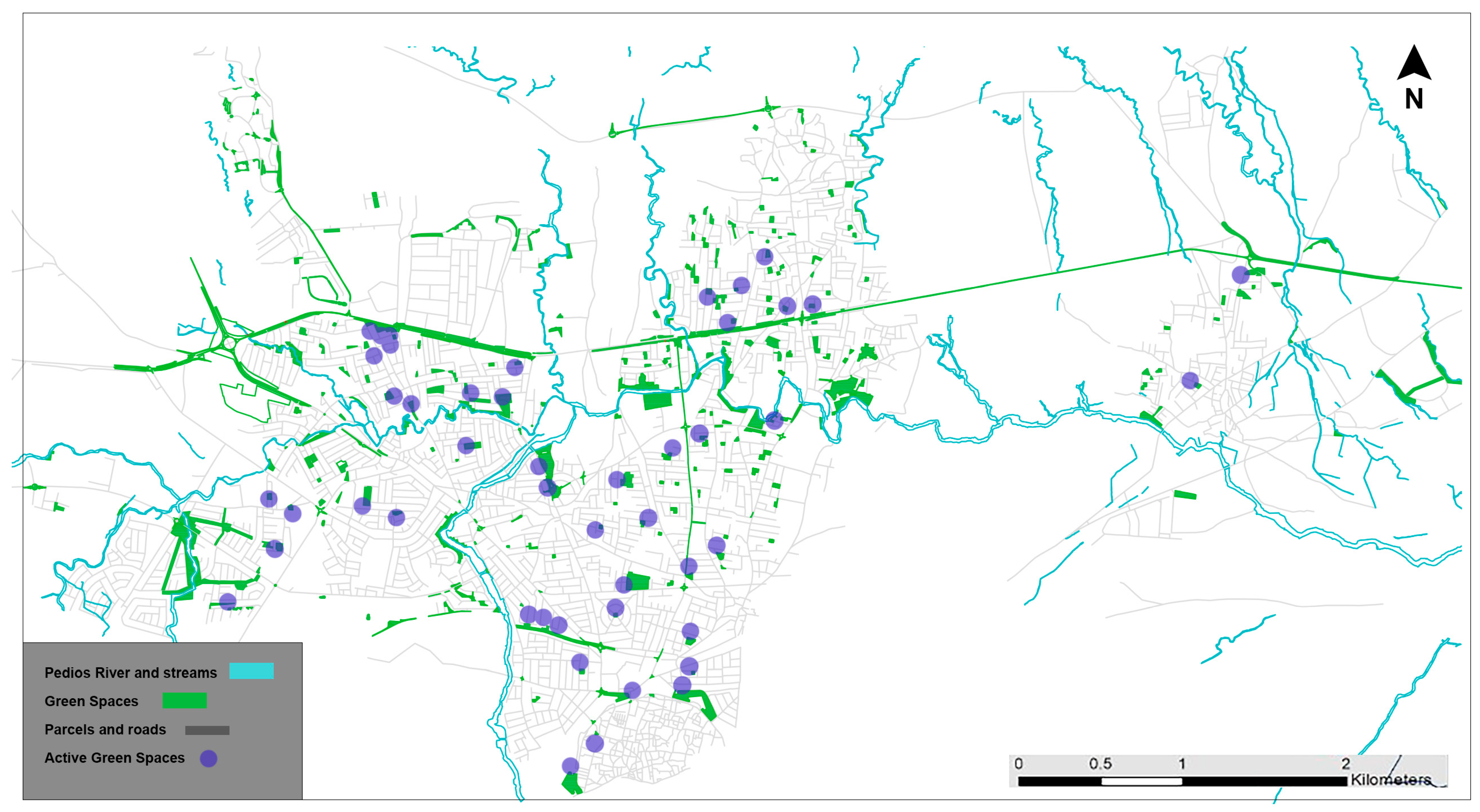
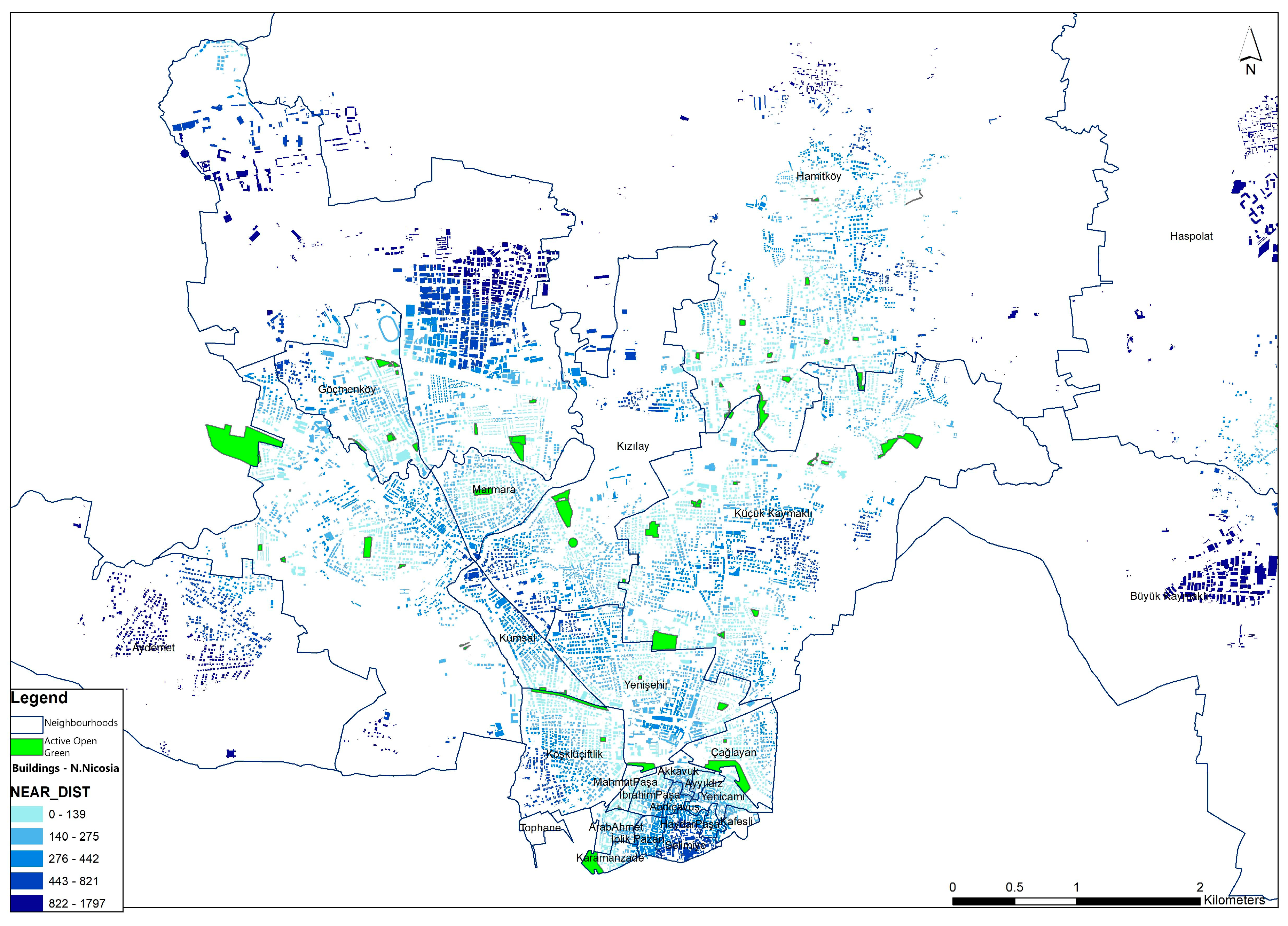
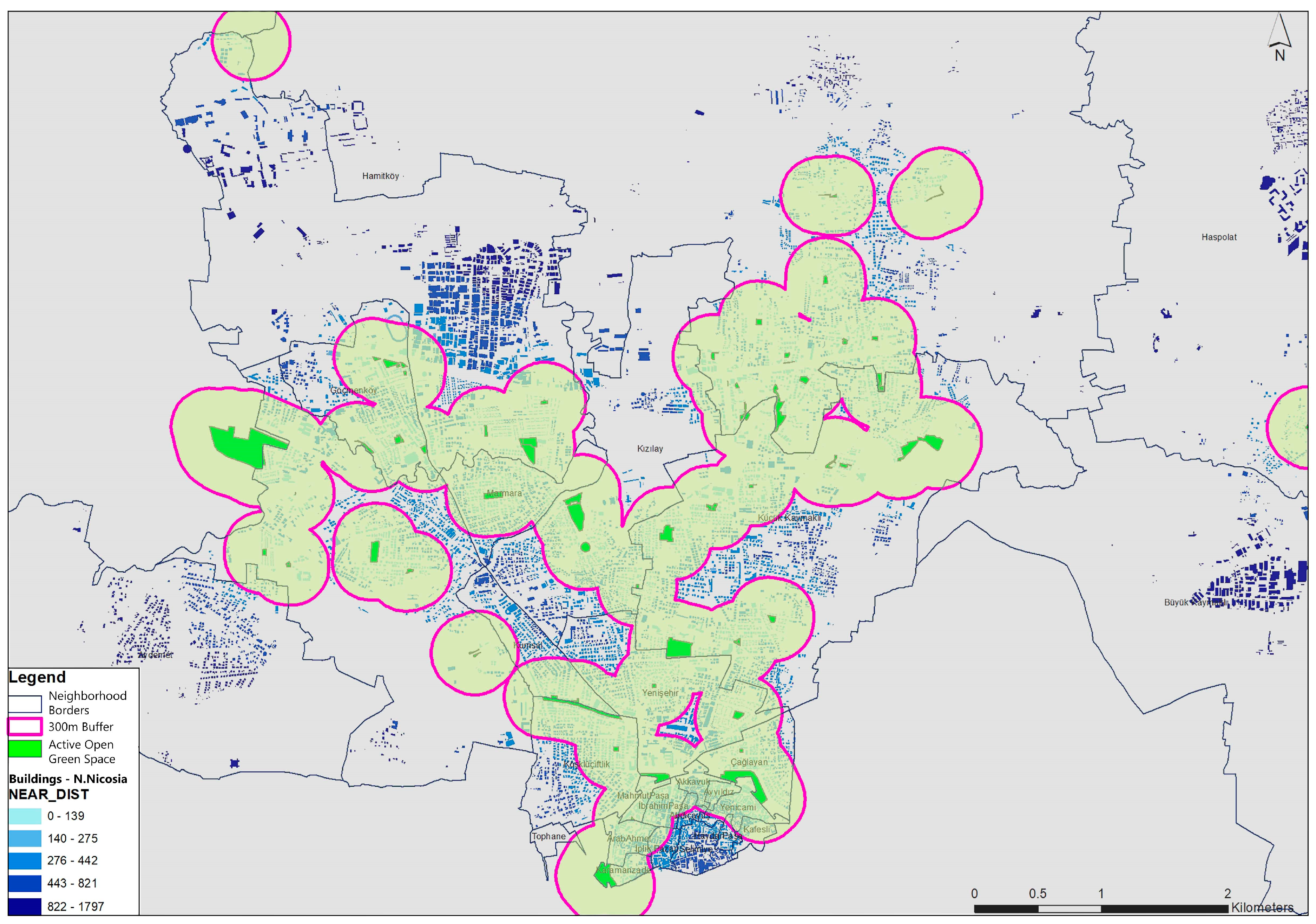
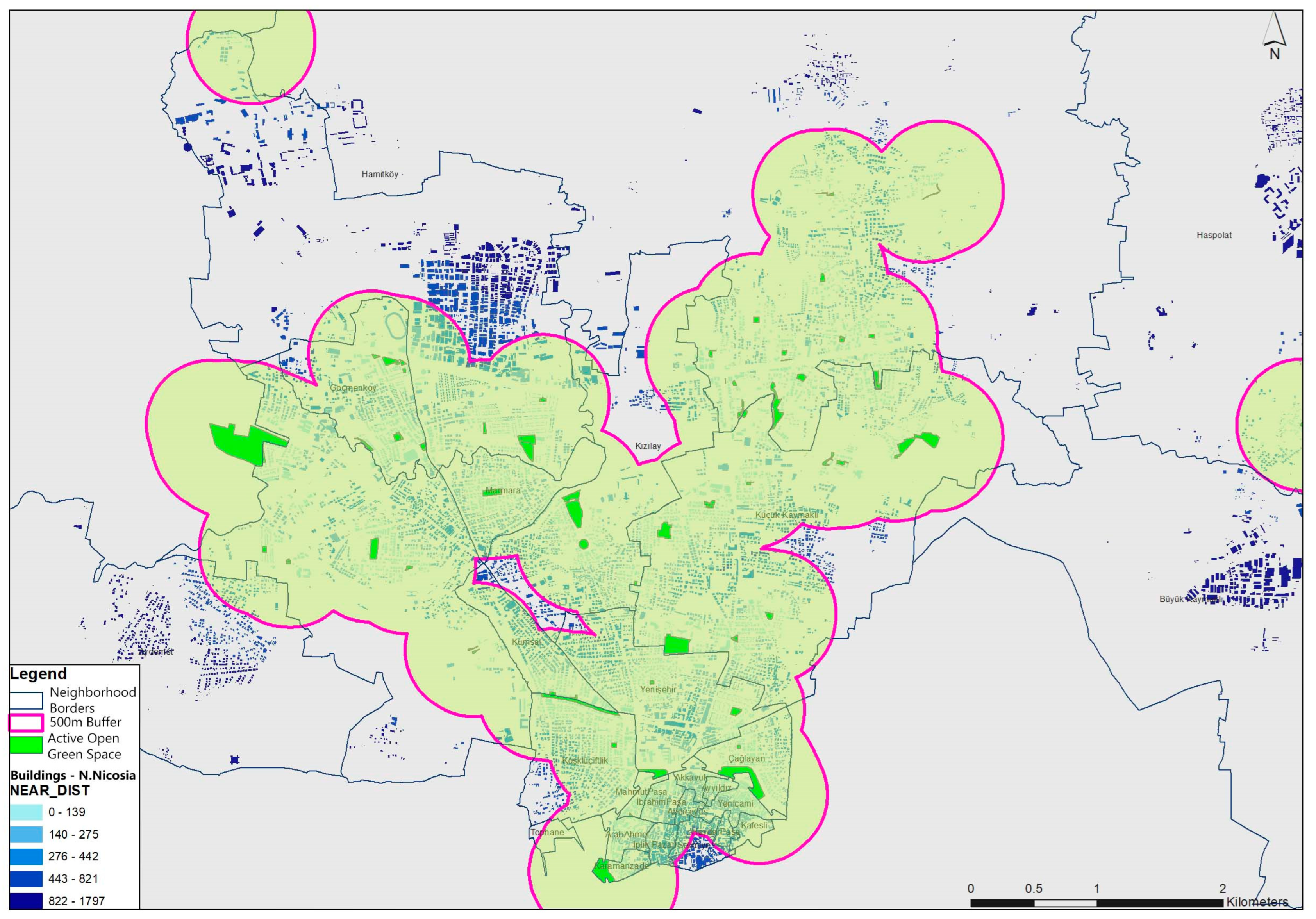
| Definition Type | Description | Example |
|---|---|---|
| Acknowledged range | A definition that acknowledged the range of what can be considered ‘greenspace’ | “greenness describes the level of vegetation, ranging from sparsely landscaped streets to tree-lined walk-ways to play field sand forested parks” |
| Definition by examples | Examples were provided to illustrate what is meant by greenspace | “combined areas of open land, cropland, urban open land, pasture, forest, and woody perennial” |
| Ecosystem services | Examples that embody ecosystem services, such as urban agriculture, and/or a reference to serving human needs | “a type of land use which has significant contributions to urban environments in terms of ecology, aesthetics or public health, and primarily serving human needs and uses” |
| Green areas | A reference to ‘green’ and/or ‘natural’ areas without further explanation | “the area investigated included substantial green elements” |
| Land uses | Generic land uses described as greenspace | “recreational or undeveloped land” |
| Vegetated areas | Areas that feature vegetation | “green in the sense of being predominantly covered with vegetation” |
| Study/Standard | Maximum Distance to Travel to Greenspace | Greenspace Size and Type |
|---|---|---|
| London Boroughs (since 1976) | 1/4 mile (0.4 km) 3/4 mile (1.2 km) | small and local parks district parks |
| Open Space Planning in London. London Planning Advisory Committee | Direct line radius of approximately 280 m | - |
| Six Acre Standard National Playing Fields Association (NPFA) | 100 m (1 min walk) 400 m (5 min walk) 1000 m (15 min walk) | local areas for play local equipped areas for play neighborhood equipped areas for play |
| Natural Spaces in Urban Places | 0.5 km 2 km 5 km 10 km | natural greenspace of at least 2 ha natural greenspace of at least 20 ha natural greenspace of at least 100 ha natural greenspace of at least 500 ha minimum 1 ha Local Nature Reserve (LNR) in every urban area per 1000 population |
| ANGST (Natural England’s Accessible Natural Greenspace Standard, | every home should be within 300 m of 2 km of 5 km of 10 km of | an accessible natural greenspace of at least 2 ha, plus at least one accessible site of 20 ha at least one accessible site of 100 ha at least one accessible site of 500 ha provision of at least 1 ha LNR per 1000 population |
| Natural environments—healthy environments? | 3 km radius around the center of the neighborhood | |
| London Plan. London’s Public Open Space Hierarchy | 8 km 3.2 km 1.2 km 400 m 400 m 400 m where feasible | regional (over 400 ha) metropolitan (60–400 ha) district (20–60 ha) local parks (2–20 ha) small local parks (0.4–2 ha) pocket parks (less than 0.4 ha) linear open spaces (variable) |
| Space for People | 500 m 4 km | accessible woodland of at least 2 ha accessible woodland of at least 20 ha |
| Is green space in the living environment associated with people’s feelings of social safety? | km or 3 km radius around homes | metropolitan |
| Classification | Description |
|---|---|
| Green spaces | Small green areas at the neighborhood scale can meet daily needs for contact with nature [40] |
| Neighborhood (local) parks | Neighborhood parks can be classified as areas serving as social or recreational activity centers for the surrounding neighborhood [41] |
| Playgrounds | They are functional open spaces in the urban fabric. Playgrounds, which form a part of open-green space systems in cities, can generally be used by children between the ages of 0 and 14 [42] |
| Sports areas | Sports fields, which form large openings and gaps, not only contribute to urban ecology but also have sociocultural value with the functions they create [42] |
| Residential compound gardens | Green land in residential compound areas. These private or semiprivate home gardens make up the majority of the cultural landscape [43] |
| Measure | Tools |
|---|---|
| Per-capita open green space | Green space maps from the Town Planning Office and 2011 Census; neighborhood maps from the Municipality |
| Proximity to green space | Neighborhood maps from the Municipality, GIS |
| Area percentages | Neighborhood maps from the Municipality, GIS |
| Types of green spaces | Green space maps from the Town Planning office and Municipality |
| Green Spaces | Green Space Area (m2) |
|---|---|
| Total green spaces | 1,065,954.581 m2 |
| Green space per capita | 17.367 m2 |
| Total active green spaces | 205,819.081 m2 |
| Active green space per capita | 3.353 m2 |
| Total passive green spaces | 860,135.5 m2 |
| Neighborhood Name | Open Green Space (m2) | Population (2011) | Active Green Space Per Capita (m2) |
|---|---|---|---|
| Abdi Çavuş | 0 | 568 | 0 |
| Akkavuk | 383.318 | 793 | 0.483 |
| Arabahmet | 0 | 561 | 0 |
| Ayyildiz | 0 | 489 | 0 |
| Haydarpaşa | 0 | 155 | 0 |
| İbrahimpaşa | 0 | 566 | 0 |
| İplikpazari | 0 | 229 | 0 |
| Kafesli | 0 | 233 | 0 |
| Karamanzade | 18,568.428 | 351 | 52.9 |
| Mahmutpaşa | 264.47 | 314 | 0.842 |
| Selimiye | 0 | 878 | 0 |
| Yenicami | 0 | 1663 | 0 |
| Aydemet | 4470.472 | 2314 | 1.932 |
| Çağlayan | 29,334.598 | 1307 | 22.444 |
| Göçmenköy | 12,660.292 | 3003 | 4.216 |
| Hamitköy | 13,267.001 | 5338 | 2.485 |
| Haspolat | 1769.695 | 4204 | 0.421 |
| Kizilay | 10,992.818 | 3535 | 3.110 |
| Köşklüçiftlik | 15,455.252 | 2939 | 5.259 |
| Kumsal | 2045.894 | 1855 | 1.103 |
| Küçük Kaymakli | 45,466.385 | 10,572 | 4.301 |
| Marmara | 6200.373 | 3081 | 2.012 |
| Ortaköy | 12,850.499 | 8868 | 1.449 |
| Taşkinköy | 19,471.744 | 3847 | 5.062 |
| Yenişehir | 12,617.842 | 3715 | 3.396 |
| Total Active Green Spaces | 205,819.081 |
| Types of Green Spaces | Number of Open Green Space | Open Green Space (m2) | Percentage of Open Green Space (%) |
|---|---|---|---|
| Green spaces | 18 | 16,403.950 | 7.97 |
| Neighborhood parks | 27 | 125,334.271 | 60.90 |
| Playgrounds | 4 | 36,949.141 | 17.95 |
| Residential mass housing gardens | 3 | 2416.402 | 1.17 |
| Sports areas | 1 | 24,715.317 | 12.01 |
| Total Active Green Spaces | 53 | 205,819.081 |
| Neighborhood Name | Open Green Space (m2) | Types of Green Spaces | ||||
|---|---|---|---|---|---|---|
| Neighborhood Parks | Playgrounds | Sports Area and Playgrounds | Residential Mass Housing Gardens | Sports Areas | ||
| Abdi Çavuş | 0 | |||||
| Akkavuk | 383.318 | 1 | ||||
| Arabahmet | 0 | |||||
| Ayyildiz | 0 | |||||
| Haydarpaşa | 0 | |||||
| İbrahimpaşa | 0 | |||||
| İplikpazari | 0 | |||||
| Kafesli | 0 | |||||
| Karamanzade | 18,568.428 | 1 | ||||
| Mahmutpaşa | 264.47 | 1 | ||||
| Selimiye | 0 | |||||
| Yenicami | 0 | |||||
| Aydemet | 4470.472 | 5 | 1 | |||
| Çağlayan | 29,334.598 | 1 | 1 | |||
| Göçmenköy | 12,660.292 | 4 | 2 | 1 | ||
| Hamitköy | 13,267.001 | 1 | 4 | 1 | ||
| Haspolat | 1769.695 | 1 | 1 | |||
| Kizilay | 10,992.818 | 1 | 2 | |||
| Köşklüçiftlik | 15,455.252 | 2 | ||||
| Kumsal | 2045.894 | 2 | ||||
| Küçük Kaymakli | 45,466.385 | 2 | 4 | 2 | ||
| Marmara | 6200.373 | 1 | ||||
| Ortaköy | 12,850.499 | 4 | 1 | |||
| Taşkinköy | 19,471.744 | 1 | 1 | 1 | 1 | |
| Yenişehir | 12,617.842 | 1 | 2 | |||
| Total Active Green Spaces | 205,819.081 | |||||
| Findings of Quantitative Characteristics | ||||||||
|---|---|---|---|---|---|---|---|---|
| Parameters | North Nicosia | Taşkınköy Neighborhood | Ortaköy Neighborhood | Küçük Kaymaklı Neighborhood | ||||
| 1. Per-capita green space | 3.353 m2 | 5.062 m2 | 1.449 m2 | 4.301 m2 | ||||
| 2. Proximity to green space (m) | 337 m | |||||||
| 3. Area percentages | 92.8 km2 | 5.87 km2 | 4.07 km2 | 4.94 km2 | ||||
| 205,819.081 m2 | 19,471.744 m2 | 12,850.499 m2 | 45,466.385 m2 | |||||
| total | 1.148% | total | 2.88% | total | 2.76% | total | 3.43% | |
| active | 0.22% | active | 0.33% | active | 0.03% | active | 0.9% | |
| 4. Types of green space | ||||||||
| Green spaces | 18 | 1 | - | 2 | ||||
| Playgrounds or parks | 27 | - | 4 | 3 | ||||
| Sports area and playgrounds | 4 | 1 | 1 | 2 | ||||
| Residential compound gardens | 3 | 1 | - | - | ||||
| Sports areas | 1 | - | - | 1 | ||||
Disclaimer/Publisher’s Note: The statements, opinions and data contained in all publications are solely those of the individual author(s) and contributor(s) and not of MDPI and/or the editor(s). MDPI and/or the editor(s) disclaim responsibility for any injury to people or property resulting from any ideas, methods, instructions or products referred to in the content. |
© 2023 by the authors. Licensee MDPI, Basel, Switzerland. This article is an open access article distributed under the terms and conditions of the Creative Commons Attribution (CC BY) license (https://creativecommons.org/licenses/by/4.0/).
Share and Cite
Bolkaner, M.K.; Asilsoy, B. Reinventing the Urban Neighborhood Green Index in the Context of Urban Ecology as a Conceptual Framework in Northern Nicosia, Cyprus. Sustainability 2023, 15, 13880. https://doi.org/10.3390/su151813880
Bolkaner MK, Asilsoy B. Reinventing the Urban Neighborhood Green Index in the Context of Urban Ecology as a Conceptual Framework in Northern Nicosia, Cyprus. Sustainability. 2023; 15(18):13880. https://doi.org/10.3390/su151813880
Chicago/Turabian StyleBolkaner, Mine K., and Buket Asilsoy. 2023. "Reinventing the Urban Neighborhood Green Index in the Context of Urban Ecology as a Conceptual Framework in Northern Nicosia, Cyprus" Sustainability 15, no. 18: 13880. https://doi.org/10.3390/su151813880
APA StyleBolkaner, M. K., & Asilsoy, B. (2023). Reinventing the Urban Neighborhood Green Index in the Context of Urban Ecology as a Conceptual Framework in Northern Nicosia, Cyprus. Sustainability, 15(18), 13880. https://doi.org/10.3390/su151813880







